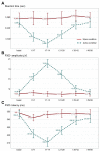Immediate effects and duration of a short and single application of transcutaneous auricular vagus nerve stimulation on P300 event related potential
- PMID: 37051148
- PMCID: PMC10083261
- DOI: 10.3389/fnins.2023.1096865
Immediate effects and duration of a short and single application of transcutaneous auricular vagus nerve stimulation on P300 event related potential
Abstract
Introduction: Transcutaneous auricular vagus nerve stimulation (taVNS) is a neuromodulatory technique that stimulates the auricular branch of the vagus nerve. The modulation of the locus coeruleus-norepinephrine (LC-NE) network is one of the potential working mechanisms of this method. Our aims were 1-to investigate if short and single applications of taVNS can modulate the P300 cognitive event-related potential (ERP) as an indirect marker that reflects NE brain activation under control of the LC, and 2-to evaluate the duration of these changes.
Methods: 20 healthy volunteers executed an auditory oddball paradigm to obtain P300 and reaction time (RT) values. Then a 7 min active or sham taVNS period was initiated and simultaneously a new P300 paradigm was performed. We successively repeated the paradigm on 4 occasions with different time intervals up to 56 min after the stimulation onset.
Results: During active taVNS an immediate and significant effect of increasing the amplitude and reducing the latency of P300, as well as a shortening in the RT was observed. This effect was prolonged in time up to 28 min. The values then returned to pre-stimulation levels. Sham stimulation did not generate changes.
Discussion: Our results, demonstrate differential facilitating effects in a concrete time window after taVNS. Literature about the modulatory effect of taVNS over P300 ERP shows a wide spread of results. There is not a standardized system for taVNS and currently the great heterogeneity of stimulation approaches concerning targets and parameters, make it difficult to obtain conclusions about this relationship. Our study was designed optimizing several stimulation settings, such as a customized earbud stimulator, enlarged stimulating surface, simultaneous stimulation over the cymba and cavum conchae, a Delayed Biphasic Pulse Burst and current controlled stimulation that adjusted the output voltage and guaranteed the administration of a preset electrical dose. Under our stimulation conditions, targeting vagal nerve fibers via taVNS modulates the P300 in healthy participants. The optimal settings of modulatory function of taVNS on P300, and their interdependency is insufficiently studied in the literature, but our data provides several easily optimizable parameters, that will produce more robust results in future.
Keywords: P300; auricular vagus nerve stimulation; event-related potentials; healthy volunteers; locus coeruleus; neurostimulation; norepinephrine; transcutaneous vagus nerve stimulation.
Copyright © 2023 Gurtubay, Perez-Rodriguez, Fernandez, Librero-Lopez, Calvo, Bermejo, Pinin-Osorio and Lopez.
Conflict of interest statement
Xana Smart Neurostimulation, provided a B version of the taVNS device for this study IG received advisory board fees from Xana. ML is the Chief Scientific officer of Xana. EF is the Chief Executive Officer of Xana. PB is the Chief Innovation Officer and DC has become the Chief Medical officer in the late part of this study. The remaining authors declare that the research was conducted in the absence of any commercial or financial relationship that could be construed as a potential conflict of interest.
Figures





Similar articles
-
Transcutaneous auricular vagus nerve stimulation cannot modulate the P3b event-related potential in healthy volunteers.Clin Neurophysiol. 2022 Mar;135:22-29. doi: 10.1016/j.clinph.2021.11.079. Epub 2021 Dec 29. Clin Neurophysiol. 2022. PMID: 35007840
-
Ear your heart: transcutaneous auricular vagus nerve stimulation on heart rate variability in healthy young participants.PeerJ. 2022 Nov 21;10:e14447. doi: 10.7717/peerj.14447. eCollection 2022. PeerJ. 2022. PMID: 36438582 Free PMC article.
-
Event-related transcutaneous vagus nerve stimulation modulates behaviour and pupillary responses during an auditory oddball task.Psychoneuroendocrinology. 2022 Jun;140:105719. doi: 10.1016/j.psyneuen.2022.105719. Epub 2022 Mar 10. Psychoneuroendocrinology. 2022. PMID: 35334389
-
Current challenges in reliably targeting the noradrenergic locus coeruleus using transcutaneous auricular vagus nerve stimulation (taVNS).Auton Neurosci. 2021 Dec;236:102900. doi: 10.1016/j.autneu.2021.102900. Epub 2021 Oct 29. Auton Neurosci. 2021. PMID: 34781120 Review.
-
Transcutaneous Auricular Vagus Nerve Stimulation Combined With Slow Breathing: Speculations on Potential Applications and Technical Considerations.Neuromodulation. 2022 Apr;25(3):380-394. doi: 10.1111/ner.13458. Epub 2021 Jun 23. Neuromodulation. 2022. PMID: 35396070 Review.
Cited by
-
Cognitive Functions following Trigeminal Neuromodulation.Biomedicines. 2023 Aug 27;11(9):2392. doi: 10.3390/biomedicines11092392. Biomedicines. 2023. PMID: 37760833 Free PMC article. Review.
-
Effects of taVNS on physiological responses and cognitive performance during a mental stressor.Cogn Affect Behav Neurosci. 2025 Sep 4. doi: 10.3758/s13415-025-01341-w. Online ahead of print. Cogn Affect Behav Neurosci. 2025. PMID: 40908377
-
Effects of Transcutaneous Auricular Vagus Nerve Stimulation on the P300: Do Stimulation Duration and Stimulation Type Matter?Brain Sci. 2024 Jul 10;14(7):690. doi: 10.3390/brainsci14070690. Brain Sci. 2024. PMID: 39061430 Free PMC article.
-
Effects of off-line auricular transcutaneous vagus nerve stimulation (taVNS) on a short-term memory task: a pilot study.Front Aging Neurosci. 2025 Apr 28;17:1549167. doi: 10.3389/fnagi.2025.1549167. eCollection 2025. Front Aging Neurosci. 2025. PMID: 40357230 Free PMC article.
-
Changes in brain functional connectivity associated with transcutaneous auricular vagus nerve stimulation in healthy controls.Front Hum Neurosci. 2025 Mar 6;19:1531123. doi: 10.3389/fnhum.2025.1531123. eCollection 2025. Front Hum Neurosci. 2025. PMID: 40115886 Free PMC article.
References
-
- Aminoff M., Eisen A. (1999). “Somatosensory evoked potentials. Nerve stimulation techniques” in Electrodiagnosis in clinical neurophysiology. ed. Aminoff M. (New York: Churchill Livingston; ), 513–536.
-
- Badran B. W., Dowdle L. T., Mithoefer O. J., LaBate N. T., Coatsworth J., Brown J. C., et al. . (2018). Neurophysiologic effects of transcutaneous auricular vagus nerve stimulation (taVNS) via electrical stimulation of the tragus: a concurrent taVNS/fMRI study and review. Brain Stimul. 11, 492–500. doi: 10.1016/j.brs.2017.12.009, PMID: - DOI - PMC - PubMed
LinkOut - more resources
Full Text Sources
Miscellaneous

